| 30 June |
• yesterday • tomorrow |
| Optional Memorial of the First Martyrs of the Holy Roman Church |
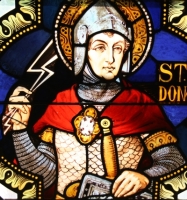
Donato
• 2nd Sunday in May (Euskirchen, Germany during which a fair is held)
• 2nd Sunday in July (archdiocese of Cologne, Germany during which a pilgrimage to his relics is held)
• 7 August (Balaton wine region in Hungary during which his intercession is asked for the wine harvest)
Son of Faustus, a non-Christian, and Flaminia, a Christian; his father was saved from a severe illness by the intercession of Saint> Gervasius, and Donatus grew up in the faith. When he was 17, he became a soldier, rose through the ranks, and in his mid-20’s he was a captain in the 12th imperial Roman legion. Around the year 166, his unit was fighting Germanic tribes along the Danube river. The Romans got surrounded and cut off from supplies, including water, for days. The pagan Romans pleaded with their gods for relief, but nothing happened. Donatus finally got all the Christian soldiers together (due to persecutions of Christians, they did not call attention to themselves) and prayed, and a storm blew in; the Romans captured all the water they needed, lightning struck the German camp, and the legion chased the tribes back across the river. However, being exposed as a Christian led to Donatus being executed. Martyr.
Later legand says that in thanks for the life-saving rain, Donatus promised to lead a single life devoted to God. For his victory against the Germans, Donatus was promoted to colonel in the personal guard of Emperor Marcus Aurelius. To solidfy his devotion to the emperor by family ties, Donatus was ordered to marry the emperor’s grand-daughter Alexandria. He refused because of his vow, and when he explained why, he was identified as a Christian and executed.
c.140 of Rome, Italy
• c.180
• buried by his mother in the Saint Agnes catacomb outside Rome
• relics re-discovered in 1646 by the Jesuit Balthasar Ballonus
• relics given to the Jesuit College church in Bad Münstereifel, Germany in 1649
• during the ceremony to enshrine the relics, on 30 June 1652, a pouring rain ended as soon as the procession of the relics began
• at the end of the Mass in which the relics were enshrined in the church of Saint Martin, lightning struck the church, lamps and candles fell, and the priest‘s vestments were set on fire at the altar; the priest called out for Saint Donatus to intercede; the fire was immediately extinguished and the priest was unharmed
• some relics in the church of Saint Michael in Weywertz, Belgium
• some relics in the abbey church in Neumünster, Luxembourg
• some relics in the church of Saint Anthony of Padua in Loosbroek, Netherlands
• some relics in the church of Saint Anthony the Abbot and Saint Donatus in Reek, Netherlands
• some relics in the church of Saint Anthony the Padua in Vragender, Netherlands
• some relics in the church of Saint Severinus in Hapert, Netherlands
• against lightning
• against storms
• against fire
• bakers
• wine makers
• Buda, Hungary
• Saint Donatus, Iowa (named in his honour by Luxembourgish immigrants)
• soldier with a knife and palm branch
• soldier holding a lightning bolt(s)
• soldier near a burning church
with Saint Florian of Llorch
https://catholicsaints.info/saint-donatus-of-munstereifel/

• Doctor Illuminatus
• Ramon Llull
• Ramon Lull
• Ramon Lullus
• Raymond Lullus
• Raymond Lully
Seneschal, courtier and troubador at the court of King James of Aragon from about 1246. Married Blanca Picany in 1257. In 1263 he received a vision of Christ crucified, and was converted on the spot.
Franciscan tertiary. Friend of Raymond of Penyafort Worked to convert Muslims in the Iberian peninsula, and then in north Africa. He tried to interest the Vatican and assorted European royal courts in this work, travelling throughout Italy, France, England and Germany in search of support, but received little help. He learned Arabic, founded a school for Arabic study on Majorca in 1276, and encouraged the study of Arab language and culture. Travelled three times to Tunis to preach to the Muslims, but was forcibly deported.
Raymond wrote over 300 works in Latin, Arabic and Catalan on theology, logic, philosophy; wrote fiction and poetry. Known as a alchemist, he had no training in occult arts, and invented his own Christian-based concepts to explain alchemical mysteries. Reputed to have solved the "lead-into-gold" mystery; legend says he worked on it to finance missionary work. He had a small but devoted band of followers known as Lullists who continued their work after his death, though some of them drifted away from the Church in search of alchemical knowledge. His work in this area has been the source of controversy for centuries, and non-Christian occult groups have seen him as a "master" or whatever term they use.
c.1234 at Palma, Majorca, Spain
• some writers indicate he was martyred by stoning in Tunis c.1315, but there is no evidence for it
• some writers indicate that he died in Bougie, Algeria in 1325
• may have died of natural causes during the return ocean voyage from Tunis
• buried at the church of San Francisco, Palma, Majorca, Spain
• 25 February 1750 by Pope Benedict XIV (cultus confirmed)
• 1847 by Pope Pius IX
https://catholicsaints.info/blessed-raymond-lull/

Januarius Maria Sarnelli
Son of the Baron of Ciorani. Civil and canon lawyer at age 20. Friend of Saint Alphonsus Maria de Liguori. While working with terminally ill patients, Gennaro felt a call to the priesthood, and in 1728 he gave up the law and entered the seminary. Ordained on 8 June 1732, he gave away all his personal property and wealth to the poor. He dedicated himself to helping and catechizing children that today we would call "at risk" of entering lives of crime, and of working to help young women out of lives as prostitutes; this last work led to many threats against him and his family from criminal elements who made money on the sex trade. Member of the Congregation of Apostolical Missions. Joined the Redemptorists in 1733. In 1736 he was sent to Naples, Italy where he worked to support the missioner work of the Redemptorists and spent his spare time ministering to the sick, the elderly, prisoners and young boys forced into labour at the docks. Wrote more than 30 books of a number of pastoral, social and theological topics, and left many more unfinished.
12 September 1702 in the castle of Duke Zapata, Naples, Italy
• 30 June 1744 in Naples, Italy of natural causes
• buried in the parish of Santa Maria dell'Aiuto in Naples
• re-interred at the Redemptorist Church of Ciorani in Salerno, Italy
12 May 1996 by Pope John Paul II
https://catholicsaints.info/blessed-gennaro-maria-sarnelli/
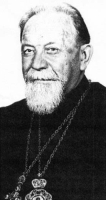
Basil
27 June as one of the Martyrs Killed Under Communist Regimes in Eastern Europe
Son of catechists Volodymyr and Anne Theodorowych Velychkovsky. Greek Catholic. Entered the seminary in Lviv, Ukraine in 1920. Ordained on 9 October 1925. Teacher and missionary in the Volyn region of Ukraine. Prior of the monastery at Ternopil, Ukraine in 1942. Arrested for his faith at Ternopil in 1945, condemned to death, and sent to Kiev, Ukraine where his sentence was changed to ten years in a forced labour camp. There he ministered to other prisoners.
His sentence served, he returned to Lviv in 1955. Bishop of the "clandestine" Ukrainian Greek Catholic Church, of the Congregation of the Most Holy Redeemer. Archbishop in 1963. Arrested again for his faith, and for listening to Vatican Radio, in 1969. Sentenced to three years in the camps, where, between torture sessions, he ministered to other prisoners. When his health failed, he was released. Travelled to Rome, Italy and then to Winnipeg, Canada. Confessor of the faith.
1 June 1903 in Stanislaviv, Ukraine
• 30 June 1973 at Winnepeg, Manitoba, Canada of natural causes
• buried in Winnepeg
• relics now enshrined in Saint Joseph's Ukrainian Catholic Church in Winnipeg
27 June 2001 by Pope John Paul II in Ukraine
https://catholicsaints.info/blessed-vasyl-vsevolod-velychkovskyi/
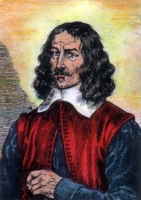
• Philip Morgan
• Philip Powell
• Philip Prosser
Son of Roger and Catherine Powel. Studied law in London, England. Seminarian in Douai, France. Joined the Benedictines at the monastery now known as Downside Abbey in Bath, England. Ordained in Douai in 1618. Returned to England in 1622 to minister to covert and oppressed Catholics. He worked in the area of Leighland, Somersetshire, sometimes using the aliases of Morgan or Prosser to avoid priest hunters, from 1624 until the Civil War broke out in 1645 when he removed to Devonshire. Served six months as chaplain to Catholic soldiers in Cornwall. While sailing to South Wales, his ship was captured on 22 February 1646. Father Philip was recognized and arrested for the crime of being a priest. Imprisoned in London in harsh conditions, he developed pleurisy. On 9 June 1646 he was tried and condemned for being a priest. Martyr.
2 February 1594 in Tralon, Brecknockshire, England
• hanged, drawn, and quartered on 30 June 1646 at Tyburn, London, England
• buried in the old churchyard at Moorfields, London
• some relics, including a crucifix he owned at his death, are enshrined at Downside Abbey, Bath, England
15 December 1929 by Pope Pius XI
https://catholicsaints.info/blessed-philip-powel/
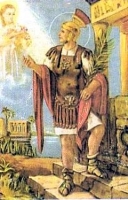
Basilide
Pagan Roman soldier. Guard to the prefect of Egypt. Defended Saint Potomiana from the mob as she was being led to her martyrdom. She appeared to Basilides in visions each of three nights after her martyrdom, claiming to be praying for him and his conversion. He converted and was martyred for his new faith.
beheaded c.205 in Alexandria, Egypt
Italian prison guards
Basilides was one of the guards that led Saint Potamiana to a martyr's death. Whilst the rest of the soldiers and the crowd of spectators insulted the holy virgin, he treated her with great respect and protected her from the assaults of the rabble. The martyr thanked him for his kindness, and promised to pray for him when she came into God's presence. A few days after her death the grace of God touched Basilides' heart, and he professed himself a Christian. His comrades at first imagined that he was jesting. But when he persevered in the confession of the Faith, he was brought before the judge, who sentenced him to be beheaded next day. Taken to prison, he was baptized, and at the appointed time, executed. - Father John J Burke, Mary, Help of Christians, 1909
https://catholicsaints.info/saint-basilides-of-alexandria/
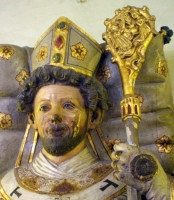
• Apostle of Pomerania
• Father of Monks
• Otho of Bamberg
Born to the Swabian nobility. Priest. Part of the household of Duke Ladislas of Poland. Entered the service of Emperor Henry IV in 1090. Chancellor in 1101. When Henry broke with Rome over the dispute of the investiture of bishops by Rome as opposed to local authorities, Otto was stuck in the middle - loyal to his emperor in matters of state, loyal to his pope in matters of spirit. Henry appointed him bishop, but Otto refused, claiming that only the true pope has such power. Henry agreed, and they journeyed to Rome where Otto was made Bishop of Bamberg. Established religious foundations, built churches, founded over 20 monasteries, and worked to heal the schism caused by Henry's break with Rome. Preacher. Evangelized in Poland, converting 20,000 pagans.
1060 in Swabia (part of modern Germany)
30 June 1139 in Pomerania (part of modern Poland)
1189 by Pope Clement III
bishop with a dog
https://catholicsaints.info/saint-otto-of-bamberg/
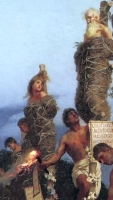
Christians who were blamed by the Roman Emperor Nero with setting fire to Rome, Italy, and were sentenced to death as punishment. They were all disciples of the Apostles. The total number of these murders is known only to God.
martyred in 64 in a variety of ways, the gorier the better from Nero's point of view; some were covered with the skins of animals and thrown to wild dogs to be torn apart; others were crucified and at sunset were covered in oil and used as human torches
O God, who consecrated that abundant first fruits of the Roman Church by the blood of the Martyrs, grant, we pray, that with firm courage we may together draw strength from so great a struggle and ever rejoice at the triumph of faithful love. Through our Lord Jesus Christ, your Son, who lives and reigns with you in the unity of the Holy Spirit, one God, for ever and ever. - collect for the liturgy of the First Martyrs of Rome
https://catholicsaints.info/first-martyrs-of-rome/
Ostian, Ostiane, Ostiano, Hostien
A relative of King Sigismund of Burgundy and Saint Venantius of Viviers. Ostianus gave away all his possessions, was ordained a priest and evangelized the area of the dioceses of Viviers and Puy in 6th century France, working with Saint Venantius. Known for healing miracles, including returning eyesight to the blind. Late in life he settled as a hermit near Viviers.
• relics enshrined by Bishop Bernoin in the mid-9th century
• in 1711 the city council of Viviers requested that the relics be processed from the church of San Martin di Couspiè through the city to end a drought
• relics rediscovered in a stone sarcophagus in 1869
• some relics transferred to the cathedral of Viviers, France on 19 August 1880
• some relics enshrined in the Saint-Ostian chapel in the church of Saint Martin di Couspiè
• Viviers, France
• for rain (in Viviers)
https://catholicsaints.info/saint-ostianus/
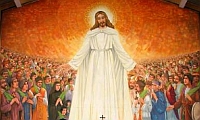
Vincent, Vincenzo
Born to a Christian family. Ordained in 1798 by Blessed Ignatius Delgado in the vicariate apostolic on Eastern Tonkin (in modern Vietnam). He was imprisoned in a government persecution of Christians in 1799, but friends ransomed him out. Joined the Dominicans on 22 July 1808 in Manila, Philippines. He was a man noted for his personal piety and forgiveness. Parish priest in Ke Sat, Vietnam; the parishioners were required to destroyed their church in the 1832 persecutions of Emperor Minh Mang. Father Vincent was arrested in February 1838 as the persecutions escalated.
c.1764 in Trà Lu, Nam Ðinh, Vietnam
• beheaded on 30 June 1838 in Hai Duong, Vietnam
• buried under the floor of the destroyed church of Tho Ninh, Vietnam
19 June 1988 by Pope John Paul II
https://catholicsaints.info/saint-vihn-son-do-yen/
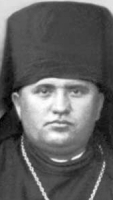
Zenone, Zynovii, Zynovij
Greek Catholic. Redemptorist, making his vows on 28 August 1926. Studied philosophy and theology in Belgium. Ordained in Ukraine on 4 September 1937. Worked in Volyn. Arrested for his faith on 20 December 1940, the Solemnity of the Immaculate Conception, during Mass while giving a homily, and imprisoned in a converted Brigittine convent. One of the Martyrs Killed Under Communist Regimes in Eastern Europe.
18 August 1903 at Ivakhiv, Ternopil's'ka oblast', Ukraine
crucified against a wall by Communists in June 1941 at Bryhidky prison, Zamarstynivska Street, Lviv, L'vivs'ka oblast', Ukraine
27 June 2001 by Pope John Paul II in Ukraine
https://catholicsaints.info/blessed-zenon-kovalyk/
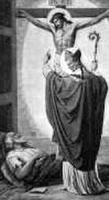
• Adolphus of Tecklenburg
• Almoner of the Poor
• Adolf, Adolfo, Adolph
11 February (Cistercian martyrology)
Count of Tecklenburg, Westphalia. Priest. Canon of Cologne, Germany, a position he resigned to become a monk at the Cistercian monastery at Camp on the Rhein. Bishop of Osnabruck, Germany in 1216. Noted for his personal piety and his extensive charity work for the poor.
1185 at Westphalia, Germany
• 30 June 1224 of natural causes
• relics enshrined in the cathedral of Osnabruck, Germany in 1651
1625 (cultus confirmation)
https://catholicsaints.info/saint-adolphus-of-osnabruck/
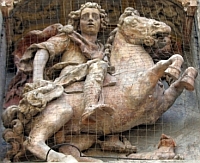
Teobaldo, Theobaldus, Thibaud, Thibaut, Thibault
Born to the French nobility. Lead to great sanctity by reading the lives of the saints. Pilgrim to several holy sites including Santiage de Compostella, Spain and Rome, Italy. Hermit at Sussy in the Trier. Leader of a group of hermits near Venice, Italy, so many that the local ordained him so he could minister the sacraments to them. Camaldolese monk. Miracle worker.
1017 at Provins, Brie, France
30 June 1066 in Sossano, Italy of natural causes
1073 by Pope Alexander II
• bachelors
• charcoal burners
• Badia Polesine, Italy
• Sossano, Italy
https://catholicsaints.info/saint-theobald/
Lucina of Rome
Wealthy convert, brought to the faith by the Apostles. She financially supported the early missionaries, visited Christians imprisoned for their faith, and gave proper burial to martyrs. Likely a martyr herself.
• Rome, Italy
• interred in the San Callistus Catacombs of Rome
• some relics transferred to Massa Lubrense, Italy in 1621
• some relics transferred to the parish of San Stefano in Rosate, Italy in 1933
• some relics transferred to the church of Santa Lucina, Cortereggio, San Giorgio Canavese, Italy
Cortereggio, Italy
https://catholicsaints.info/saint-lucina-of-the-callistus-catacombs/
Bertichramnus, Bertram, Bertran, Berti-Chramnus
Educated and ordained in Paris, France by Saint Germanus of Paris. Worked at the cathedral school at Paris, and served as archdeacon of the city. Bishop of Le Mans, France in 587. Noted for his generosity, personally and from his position, to the poor. Founded a monastery, hospice, and church in his diocese. Known for his farming skills, excellent vineyards, and quality wine. Forced to take sides in factional disputes of the day, he was repeatedly driven into exile. Re-instated permanently to his diocese by King Clotaire II in 605.
c.553 at Autun, France
30 June 623 of natural causes
https://catholicsaints.info/saint-bertrand-of-le-mans/
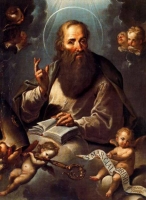
Marcial
Missionary bishop who was sent with Saint Denis of Paris to evangelize Gaul (modern France), and who settled on Limoges as his see city. Spiritual teacher of Saint Valeria and Saint Aurelian of Limoges. Worked with Saint Alpinian of Limoges and Saint Austriclinian of Limoges.
Legends arose in the Middle Ages that described him as a friend of Jesus, and a worker of extravagant miracles, who was dispatched to Gaul by Saint Peter the Apostle. Good story, but about two centuries off the mark.
Limoges, France
https://catholicsaints.info/saint-martial-of-limoges/

Peter of Asti
Legend says that Peter was an 11th century farmer from Castagnole Monferrato, Italy who miraculously dug a spring to supply a convent built in a place with no water. He founded a hospital next to the church of Saint Mary which later became the church of San Pietro in his hounour.
relics enshrined in the church of San Pietro in Consavia, Borgo San Pietro, Asti, Italy
barrel, shovel
https://catholicsaints.info/saint-peter-the-farmer/
• Arnulf Cornibout
• Arnulph, Arnulphus, Arnoul
After a wasted youth, at age 22 he had a conversion and became a Cistercian lay brother at Villers, Belgium. There he became known for the his ascetic life and charity, his prayer life, and desire to make up for his past. Had a great devotion to the Blessed Virgin Mary.
c.1180 in Brussels, Belgium.
Friday 30 June 1228 of natural causes
https://catholicsaints.info/blessed-arnulf-of-villers/
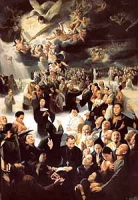
Rimen
Married layman in the apostolic vicariate of Southeastern Zhili, China. Martyred in the Boxer Rebellion.
c.1841 in Chentuncun, Jiaohe, Hebei, China
beaten to death on 30 June 1900 in Chentuncun, Jiaohe, Hebei, China
1 October 2000 by Pope John Paul II
https://catholicsaints.info/saint-raimundus-li-quanzhen/

Baiduo
Married layman in the apostolic vicariate of Southeastern Zhili, China. Martyred in the Boxer Rebellion.
c.1837 in Chentuncun, Jiaohe, Hebei, China
beaten to death on 30 June 1900 in Chentuncun, Jiaohe, Hebei, China
1 October 2000 by Pope John Paul II
https://catholicsaints.info/saint-petrus-li-quanhui/
Imperial Roman matron in the reign of emperor Nero. Convert, brought to the faith by the work of the Apostles in Rome. She gave of her fortune to support the work of the Apostles, visited Christians imprisoned for their faith, and gave Christian burial to martyrs, including Saint Processus and Saint Martinian.
• c.70
• relics believed to be hers enshrined in the church of Santa Cecilia in Trastevere, Rome, Italy
https://catholicsaints.info/saint-lucina-of-rome/
Jacques
Premonstratensian monk. Canon of the Saint Nicholas monastery in Veurne, Belgium. Cured of a fever by participating in a Passion procession; returning to his house, he built a way of the cross in gratitude. In 1637, with the helped of local Capuchin monks, he started a procession tradition that continues to today.
c.1600 in the Netherlands
30 June 1648
https://catholicsaints.info/blessed-jacob-clou/
Ambrogio
Born to a wealthy family in the Italian nobility. Cistercian monk, joining at the Charterhouse of Chiusa Pesio, Italy; he was known for his devotion to the strict monastic life. Prosecutor of the Cistercians.
in Bene Vagienna, Cuneo, Italy
30 June 1540 in Chiusa Pesio, Cuneo, Italy
https://catholicsaints.info/blessed-ambrose-de-feis/
Mercedarian friar. Commander of the convent of Santa Maria in Tolosa, Spain. Provincial of the Mercedarians in France. Chosen Master General of the Mercedarians on 6 November 1575. Known for his piety, and as a miracle worker.
August 1577 in the convent of Toulouse, France of natural causes
https://catholicsaints.info/blessed-anthony-de-tremoulieres/
Clotsend, Clotsendis
Daughter of Saint Adalbald of Ostrevant and Saint Richrudis of Marchiennes. Benedictine nun at the convent of Marchiennes under the spiritual direction of her mother. Abbess of the house.
c.635
714
https://catholicsaints.info/saint-clotsindis-of-marchiennes/

Erentrudis, Ermentrude
Relative of Saint Rupert of Salzburg worked with him as a missionary. Benedictine nun. First abbess at Nonnberg convent, Salzburg, a house founded by Rupert.
c.718 of natural causes
https://catholicsaints.info/saint-erentrude/
Elisabeth Hainburg
13th-century Dominican nun in Diessenhofen am Rhein, Thurgau, Switzerland.
c.1310
https://catholicsaints.info/blessed-elisabeth-heimburg/
Priest in the diocese of Limoges, France. Worked with Saint Martial of Limoges.
c.250
https://catholicsaints.info/saint-austriclinian-of-limoges/
Sixth century Welsh princess, the daughter of chieftain Caradog of Glamorgan, Wales. Founded the convent of Cor-Eurgain in Wales, a house later known as Llanwit.
https://catholicsaints.info/saint-eurgain/
Airick
Eleventh century hermit in northern England. Friend of Saint Godric of Finchale.
https://catholicsaints.info/saint-alrick-the-hermit/
Priest in the diocese of Limoges, France. Worked with Saint Martial of Limoges.
c.250
https://catholicsaints.info/saint-alpinian-of-limoges/
Bishop of Pamplona, Spain. Attended the sixth Council of Toledo in 737.
c.757
https://catholicsaints.info/saint-marcian-of-pampeluna/
A virgin-martyr.
martyred in Rome, Italy, date unknown
https://catholicsaints.info/saint-emiliana-of-rome/
Caius, Cursinus
Priest. Martyr.
https://catholicsaints.info/saint-gaius/
Sub-deacon. Martyr.
https://catholicsaints.info/saint-leo-the-deacon/
Seven Christians martyred together. No detail about them have surived but the names – Cursicus, Gelatus, Italica, Leo, Timotheus, Zoilus, and Zoticus.
unknown location in Africa, date unknown
https://catholicsaints.info/martyrs-of-africa-30-june/
• Dominic of La Vid
• Ernst of Prague
CatholicSaints.Info Portable Edition